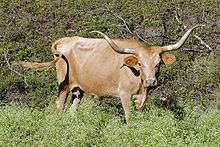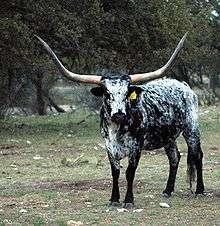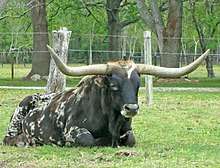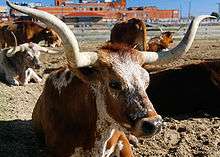Texas Longhorn
The Texas Longhorn is a breed of cattle known for its characteristic horns, which can extend to over 70 inches (1.8 m) tip to tip for bulls, and up to 100 inches (2.54 m) tip to tip for steers and exceptional cows.[1] They are descendants of the first cattle introduced in the New World, brought by explorer Christopher Columbus and the Spanish colonists.
 | |
| Conservation status | Critical |
|---|---|
| Country of origin | United States of America |
| Traits | |
| Coat | brown, white, black |
| Horn status | horned, large thick horns |
| |

Descended from cattle that thrived in arid parts of Southern Iberia, these cattle have been bred for a high drought-stress tolerance. Texas Longhorns are known for their diverse coloring, and can be any color or mix of colors, but dark red and white color mixes are the most dominant.
Registries for the breed include the Texas Longhorn Breeders Association of America, founded in 1964 by the Kerr County rancher Charles Schreiner, III; the International Texas Longhorn Association, and the Cattlemen's Texas Longhorn Registry.[2] The online National Texas Longhorn Museum displays the diversity of horns found in the breed, stories about notable individual cattle of the breed, as well as a gallery of furniture made from cattle horns.[3]
The longest recorded total-horn-length marks is 129.5 inches (3.29 m), the spread of longhorn M Arrow Cha-Ching. This longhorn is owned by Richard Flip, who lives near Fayetteville, Texas. The second longest on record is 3S Danica of Tallgrass Cattle Company, who measured 100 inches (2.54 m) tip to tip on September 13, 2018.[4]
Due to their innate gentle disposition and intelligence, Texas Longhorns are increasingly being trained for steer riding, including being used in parades.[5][6]
History of the cattle


Genetic analyses show that the Texas Longhorn originated from an Iberian taurine lineage descending from the domestication of the wild aurochs in the Middle East and with some admixture with the European Aurochs, and later (while in America) was crossed with "indicine" cattle, descending from the domestication of aurochs in India, 85% and 15%, respectively by proportion.[7]
The Texas Longhorns are direct descendants of the first cattle introduced to the New World. The ancestral cattle were brought by colonizer Christopher Columbus in 1493 to the Caribbean island that would become Hispaniola, to supply food to colonists. Between 1493 and 1512, Spanish colonists brought additional cattle in subsequent expeditions.[8] The cattle consisted of three different breeds; Barrenda, Retinto and Grande Pieto.[9]
Over the next two centuries the Spanish used the cattle in Mexico and gradually moved them north to accompany their settlement. They reached the area that would become known as Texas near the end of the 17th century. The cattle escaped or were turned loose on the open range, where they remained mostly feral for the next two centuries. Over several generations, descendants of these cattle developed to have high feed- and drought-stress tolerance, and other "hardy" characteristics that have gained Longhorns their high reputation as livestock.[10][11]
Early Anglo-American settlers in east Texas, then part of Mexico, obtained feral Mexican cattle from the borderland between the Nueces River and the Rio Grande. They bred them to their own eastern cattle. The result was a tough, rangy animal with long legs and long horns, extending up to seven feet. The interbreeding produced changes in color of the breed. The varieties of color ranged from bluish-grey, and various yellowish hues, to browns, black, ruddy and white, both cleanly bright and dirty-speckled.[12]
Portuguese cattle breeds, such as Alentejana and Mertolenga, are the closest existing relatives of Texas Longhorns.[13][14]
Decline and revival
As Texas became more densely settled through increased migration after it was annexed by the US, the frontier was developed for crop farms and ranch lands. The leaner beef of the Texas Longhorn was not as attractive in an era where tallow was highly prized. The breed's ability to survive on the poor vegetation of the open range was not as important as the range was enclosed.
Other breeds demonstrated traits more highly valued by the modern rancher, such as the ability to gain weight quickly for marketing as beef. The Texas Longhorn stock slowly dwindled, but in 1927 the breed was saved from near extinction by enthusiasts from the United States Forest Service. They collected a small herd of stock to breed on the Wichita Mountains Wildlife Refuge in Lawton, Oklahoma.[15] The breed also received significant attention after a Texas Longhorn named "Bevo" was adopted as the mascot of The University of Texas at Austin in 1917. The animal's image became commonly associated with the school's sports teams, known as the Texas Longhorns.
A few years later, J. Frank Dobie and others gathered small herds to keep in Texas state parks. Oilman Sid W. Richardson helped finance the project.[16] The Longhorns were cared for largely as curiosities, but the stock's longevity, resistance to disease, and ability to thrive on marginal pastures resulted in a revival of the breed as beef stock and for their link to Texas history. In 1995 the Texas Legislature designated the Texas Longhorn as the state mammal (large).[17]
In the 21st century, Texas Longhorns from elite bloodlines can sell for $40,000 or more at auction. The record of $380,000 on March 18, 2017, was for a cow, 3S Danica, and heifer calf at side, during the Legacy XIII sale in Fort Worth, Texas.[18] Commercial ranchers cross-breed Texas Longhorns with other breeds for increasing hybrid vigor and easy calving characteristics. Smaller birth weights reduce dystocia for first-calf heifers.
References
- Siebert, Charles (July 2011). "Food Ark". National Geographic.
- "Cattlemen's Texas Longhorn Registry". Cattlemen's Texas Longhorn Registry. Retrieved December 13, 2013.
- "The Alan Rogers Texas Longhorn Museum". longhornmuseum.com.
- "A $380,000 Longhorn? A Look At The Never-ending Race For The Biggest Horns In Texas". Texas Standard. Retrieved September 13, 2018.
- "A fresh mount: Bob McCormick breaks longhorn steer to ride for bicentennial parade". Tri-Stock Livestock News. Retrieved September 5, 2018.
- "Oklahoma couple breeds longhorns for riding". The Fence Post. Retrieved September 5, 2018.
- McTavish, Emily Jane; Jared E. Decker; Robert D. Schnabel; Jeremy F. Taylor; David M. Hillis (2013). "New World cattle show ancestry from multiple independent domestication events". PNAS. 110: E1398–406. doi:10.1073/pnas.1303367110. PMC 3625352. PMID 23530234.
- Rouse, John E. (1977). The Criollo: Spanish Cattle in the Americas. Norman, Oklahoma: University of Oklahoma Press.
- Stacy, Lee (2003). Mexico and the United States. Tarrytown, New York: Marshall Cavendish. p. 233. ISBN 0761474021.
- Barragy, Terrence J. (2003). Gathering Texas Gold. Cayo del Grullo, TX: Cayo Del Grullo Press. ISBN 9780961160487.
- University of Texas at Austin (March 25, 2013). "Decoding the genetic history of the Texas longhorn". ScienceDaily. Retrieved April 7, 2013.
- Hoyt, Alan M. "History of the Texas Longhorns". Double Helix Ranch.
- Hillis, David M. "Frequently Asked Questions about Texas Longhorn Cattle". Double Helix Ranch.
- Kidd, K. K.; et al. (1980). "Immunogenetic and Population Genetic Analyses of Iberian Cattle". Animal Blood Groups, Biochemistry and Genetics. 11 (1): 21–38. PMID 7396241.
- Donald E. Worcester. "Longhorn Cattle," Handbook of Texas Online. Published by the Texas State Historical Association.
- Galbraith, Kate. "Symbol of Texas Owes its Survival in Part to Oklahoma". The Texas Tribune. Retrieved October 12, 2012.
- "Texas State Symbols". Texas State Library and Archives Commission. tsl.texas.gov. Retrieved July 7, 2019.
- "Texas Longhorn Cow Sells For $380,000.00". rightsidesd.com. March 19, 2017.
Further reading
| Wikimedia Commons has media related to Texas Longhorn cattle. |
- Will C. Barnes, "Wichita Forest Will Be Lair of Longhorns", The Cattleman, April 1926.
- Dan Kilgore, "Texas Cattle Origins", The Cattleman, January 1983.
- James Westfall Thompson, History of Livestock Raising in the United States, 1607-1860 (Washington: U.S. Department of Agriculture, 1942).
- James Frank Dobie, The Longhorns (Austin, Texas: University of Texas Press, 1980) (ISBN 029274627X).
- Don Worcester, The Texas Longhorn: Relic of the Past, Asset for the Future (College Station: Texas A&M University Press, 1987) (ISBN 0890966257).
- Premier Longhorns-Information About Texas Longhorns